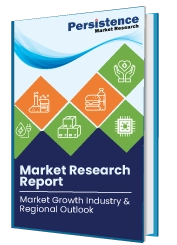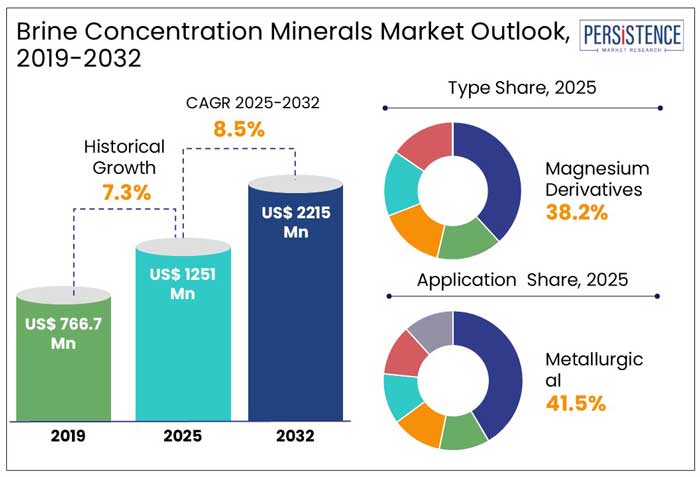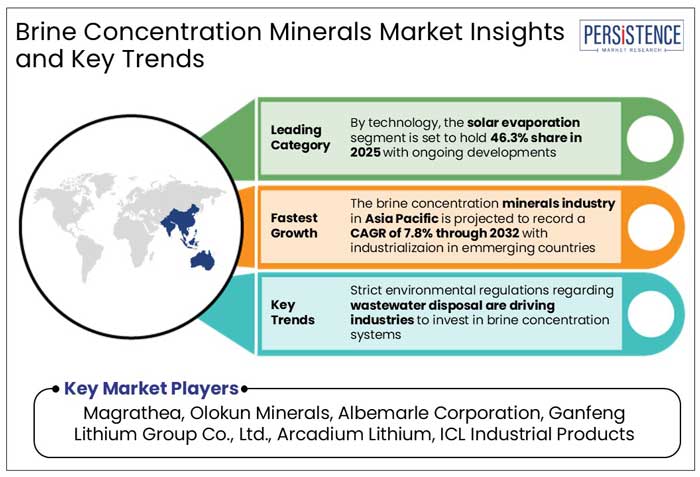ID: PMRREP35119| 188 Pages | 12 Feb 2025 | Format: PDF, Excel, PPT* | Chemicals and Materials

The global brine concentration minerals market is estimated to reach a size of US$ 1,251 Mn in 2025. It is predicted to rise at a CAGR of 8.5% through the assessment period to attain a value of US$ 2,215 Mn by 2032.
Growing demand for lithium-ion batteries and improvements in water treatment and desalination technologies are driving growth in the brine concentration minerals market. Increasing demand for lithium, a crucial component in EV batteries, is primarily driven by innovative extraction methods that enhance efficiency and environmental sustainability. For instance,
In the purification and desalination procedures of brine-derived water treatment, especially in arid locations such as the Middle East and North Africa, magnesium and potassium are essential minerals. Minerals like magnesium, potassium, and bromine are finding a variety of uses outside of their conventional applications. Technological developments and huge expenditures on water infrastructure projects are driving market growth.
For example, magnesium is utilized in lightweight alloys for the automotive and aerospace industries, while potassium compounds are integral in healthcare supplements and pharmaceuticals. The brine concentration minerals market is likely to experience growth in the next ten years due to its evolving applications and commitment to sustainable practices.

Key Highlights of the Market
|
Market Attributes |
Key Insights |
|
Brine Concentration Minerals Market Size (2025E) |
US$ 1,251 Mn |
|
Projected Market Value (2032F) |
US$ 2,215 Mn |
|
Global Market Growth Rate (CAGR 2025 to 2032) |
8.5% |
|
Historical Market Growth Rate (CAGR 2019 to 2023) |
7.3% |
North America is set to hold 28.6% of the global brine concentration technology market share in 2025, with a forecast CAGR of 6.5% from 2025 to 2032. It is driven by investments in novel purification and desalination technologies.
Demand for water purification solutions due to environmental concerns, as well as the development of high-efficiency brine management technologies for industrial wastewater treatment and sustainable water usage, drove a 10.2% growth in the desalination market in North America in 2023.
Companies in North America are spearheading brine concentration technology developments due to increased regulatory emphasis on sustainability and water saving.
Asia Pacific is projected to hold 42.3% of the global market share in 2025. The region's demand for brine-extracted minerals, such as lithium, potassium, and magnesium, is set to report a CAGR of 7.8% from 2025 to 2032.
China's economic power, vast manufacturing sector, and position as the world's largest EV producer have led to an 18% growth in lithium consumption in 2023, fueled by its booming battery production capacity. For example,
Magnesium derivatives are likely to dominate the brine concentration minerals market, accounting for 38.2% of share in 2025, due to their widespread use in various industries. The rise in lightweight automotive components has boosted magnesium alloy demand, resulting in a 12% increase in global magnesium consumption in 2023, thereby promoting sustainable transportation.
In agriculture, magnesium sulfate is widely used as a fertilizer, with Israel Chemicals Ltd. (ICL) launching a new magnesium-enriched product line in November 2023. Magnesium oxide systems are gaining popularity in the construction industry for fire resistance, with unique fire-rated boards introduced by Magnesium Oxide Systems Ltd. in late 2023.
The metallurgical segment is anticipated to hold 41.5% of the global brine concentration minerals market share, driven by demand for refractories in steel production, non-ferrous metal processing, and glass manufacturing. Brine-derived minerals like MgO, CaO, and alumina are crucial for producing heat-resistant refractory materials, and global steel production increased by 4.8% in 2023, boosting demand for high-performance refractories. For instance,
Demand for brine concentration technology is increasing due to rising need for lithium extraction in EV batteries and industrial wastewater treatment in chemical manufacture. Zero Liquid Discharge (ZLD) systems are gaining traction as industries adopt brine concentration technologies to minimize wastewater discharge. For instance,
Brine concentration techniques are being used in mining operations due to water constraints, but membrane-based systems and cutting-edge procedures like Counter Flow Reverse Osmosis are increasing productivity and environmental compliance. To meet stringent environmental requirements, the agriculture industry is taking advantage of the rising demand for minerals like potash and magnesium, which is driving investment in cutting-edge brine concentration technology.

The global brine concentration reserves market recorded a CAGR of 7.3% in the historical period from 2019 to 2023. In the same period, the industry experienced geographical expansion as well as technological developments in brine concentration. For instance,
Demand for brine concentrations is estimated to record a considerable CAGR of 8.5% during the forecast period between 2025 and 2032.
Concerns over Water Scarcity to Bolster Adoption
Brine concentration methods are being adopted for mineral extraction and water recovery due to water shortages, particularly in mining operations that need sustainable water management. The need for sustainable water solutions, such as enhanced desalination and zero-liquid discharge systems, drove a 12.5% rise in global expenditures in industrial water recycling in 2023. For instance,
Brine concentration technology is becoming vital for efficient operations and ethical resource management as governments tighten water rules and businesses prioritize sustainability.
Surging Lithium Extraction Projects from Brine Resources
Rising demand for lithium-ion batteries, in the electric vehicle sector drives investment in lithium extraction projects from brine resources. Since brine-based lithium extraction is more economical and has less environmental impact, it is becoming popular. In 2023, demand for lithium will rise by 21% worldwide as EV makers look for high-purity, sustainable supplies. For instance,
Automakers like Tesla and BYD are increasing EV production, requiring lithium extraction from brine resources to meet supply chain demands and maintain global electrification.
High Prices of Minerals and Complex Operations
Low mineral concentration and selective mineral recovery provide problems for the brine concentration minerals industry. Low starting concentrations can make the extraction process, which entails separating and concentrating target minerals, difficult. More processing stages and sophisticated technology are needed for selective recovery.
High operating costs and problems with product quality are caused by the energy-intensive extraction process, which includes evaporation, precipitation, and crystallization. This is especially evident in electronics. Innovative approaches are required to counter these, such as sophisticated process control techniques and energy-efficient extraction systems.
Mineral price volatility is a significant challenge influenced by global demand, geopolitical events, and technological advancements. Industry players must adopt strategic measures, diversify applications, optimize extraction processes, and explore long-term contracts.
Development of Specialized Technology Displays Beneficial Prospects
New extraction, processing, and purifying techniques brought about by technological developments in brine concentrating minerals increase economic viability and lower production costs while providing efficiency, sustainability, and competitiveness.
The efficiency and operational costs of mineral recovery are increased by technological developments in membrane-based systems. Environmentally friendly extraction techniques, such as closed-loop systems, waste reduction plans, and better energy use, are made possible by technical breakthroughs.
Such developments broaden the market for brine-extracted minerals beyond conventional applications to include new industries including sophisticated ceramics, aerospace, and medicines. Adapting extraction procedures to the unique requirements of various sectors increases market penetration and opens up new business prospects.
Rising Desalination Projects Worldwide
Surging desalination facilities throughout the world provide chances to extract minerals from concentrated brine streams. Desalination capacity is predicted to rise from 115 million cubic meters per day in 2024 to over 150 million cubic meters per day by 2030 due to growing worries about water shortages worldwide.
Innovation in mineral extraction is being driven by technological developments in brine mining, such as Veolia's Zero Brine program and Gradiant's selective ion recovery technique. Companies like EnergyX and Lilac Solutions are using direct lithium extraction methods to recover lithium from desalination brine, addressing the growing demand from the electric vehicle battery sector.
The brine concentration minerals market is experiencing a dynamic shift, characterized by a series of continuous developments that promise to drive its growth. Key activities, such as innovative product launches, strategic mergers and acquisitions, collaborative agreements, and expansions, are shaping the landscape of this market.
Key manufacturers in the market are actively pursuing new product introductions along with cutting-edge technological developments to maintain their competitive edge and strengthen their position. These initiatives not only cater to evolving consumer demands but also enhance efficiency and sustainability in mineral extraction and processing.
Recent Industry Developments
By Type
By Application
By Technology
By Region
The market size is set to reach US$ 2,215 Mn by 2032.
Rare earth metals, precious metals, radioactive metals, and alkaline metals are examples of metals that can be found in various forms.
In 2025, North America is set to attain a market share of 28.6%.
In 2025, the market is estimated to be valued at US$ 1,251 Mn.
Magrathea, Olokun Minerals, Albemarle Corporation, and Ganfeng Lithium Group Co., Ltd., are a few key players.
|
Attributes |
Details |
|
Forecast Period |
2025 to 2032 |
|
Historical Data Available for |
2019 to 2023 |
|
Market Analysis |
US$ Million for Value |
|
Key Regions Covered |
|
|
Key Market Segments Covered |
|
|
Key Companies Profiled in the Report |
|
|
Report Coverage |
|
|
Customization and Pricing |
Available upon request |
Delivery Timelines
For more information on this report and its delivery timelines please get in touch with our sales team.
About Author